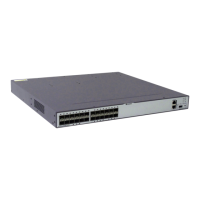Applicable Environment
An NSSA allows the transmission of Type 7 LSAs, which are generated by ASBRs in an NSSA.
The Type 7 LSAs converting into Type 5 LSAs in the NSSA and advertised to other areas.
Pre-configuration Tasks
Before configuring an OSPFv3 NSSA, complete the following tasks:
l Configuring IP addresses for interfaces to make neighboring nodes reachable
l Configuring basic OSPFv3 functions
Data Preparation
To configure an OSPFv3 NSSA, you need the following data.
No. Data
1 Cost of the default route sent to an NSSA
5.6.2 Defining the Current Area to Be an NSSA Area
Derived from a stub area, an NSSA allows AS external routes to be imported; an ASBR
advertises Type 7 NSSA LSAs in the local NSSA.
Context
Do as follows on the OSPFv3 router:
Procedure
Step 1 Run:
system-view
The system view is displayed.
Step 2 Run:
ospfv3 [ process-id ]
The OSPFv3 process view is displayed.
Step 3 Run:
area area-id
The OSPFv3 area view is displayed.
Step 4 Run:
nssa [ default-route-advertise [ cost cost | type type | tag tag ]
*
| no-import-
route | no-summary | translator-always | translator-interval translator-interval |
set-n-bit ]
*
An area is configured as an NSSA.
----End
S6700 Series Ethernet Switches
Configuration Guide - IP Routing 5 OSPFv3 Configuration
Issue 01 (2012-03-15) Huawei Proprietary and Confidential
Copyright © Huawei Technologies Co., Ltd.
198

